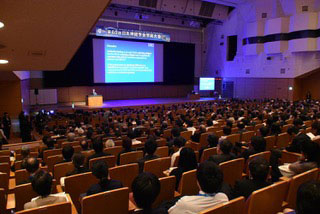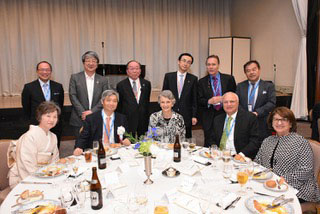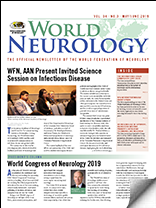By Raad Shakir, Susumu Kusunoki, and Hidehiro Mizusawa
Neurology typically flourishes in the country that hosts a World Congress. It was most evident during Japan’s annual congress held May 22-25, 2019, in Osaka. The sense of achievement of holding the largest ever WCN in Kyoto 2017 is clear to see.
There may also be a sense of internationalism and globalization driving the Japanese Society of Neurology in its efforts to showcase what is happening in Japan generally, and in neurology specifically.

The plenary session
The specific issues related to the Japanese aging population coupled with a diminishing workforce are much on the minds of all. Neurology will play a major role in supporting this rather specific situation. It is clear that neurology needs to expand on the service side as well as in research and development. This will happen with the dedication and perseverance of JSN to show government that neurological diseases are a major cause of disability, especially in an aging population.
This year’s congress is the first in the new imperial era Reiwa, which best translates to “peaceful harmony.” It is clear that the future of neurology is secure and prospering. The congress attracted 7,900 participants, which is another record. There were sessions in English throughout with 47% of scientific symposia and 43% of oral sessions being in English.
What was noticeable is that not only international speakers, but more importantly, Japanese neurologists and neuroscientists were presenting in English to packed halls. This trend extended to poster sessions, and 40% were in English. This makes international publication of Japanese work easier for all concerned. It was easy for the non-Japanese speakers to have a choice of topics throughout the day.
Prof. Susumu Kusunoki, congress president; Prof. Tatsushi Toda, president of JSN; Prof. Hidehiro Mizusawa, president of WCN 2017; and members of the board have worked hard to produce a rich program with 718 oral presentations and 1,200 posters.

Some of the speakers and the JSN board.
The Japanese scientific output is impressive and increasing, which was reflected in the topics of the congress. Work on neurogenetics, neuroimmunology, and other neuroscience new frontiers was most impressive, and the session halls offered standing room only. There were 55 international invited speakers enriching the program.
It is most noticeable that East Asian original work was evident, and the support provided to neurologists from China, Korea, Mongolia, and Taiwan, among others, was important to showcase the involvement of the JSN in promoting regional neurology.
Post-WCN Kyoto 2017, neurology in Japan has definitely grown and prospered. Perhaps more importantly, it created a sense of even more internationalist engagement, which will prove to be crucial for the progress of neurology in Japan as well as globally.
The involvement of JSN in the Asian and Oceanian Association of Neurology (AOAN) is longstanding and fundamental. It is important to note the Japanese neurologists are founding members, and their continued support has been cemented by the success of WCN Kyoto 2017. The region certainly needs all of the support both financial and scientific as it has the largest world populations with its clear and enormous needs. In order for neurology to flourish, the JSN has always played its role in support and participation in all regional and international activities.
The JSN currently has 9,169 members, which makes it one of the larger national societies and this places an obligation on the JSN board to advise, guide, and support neurologists from across the world especially those from low and low middle income countries. This is certainly advanced by large congresses and provision of grants to young neurologists to attend and present their work. It is in a way the duty of larger societies in more prosperous countries to provide support and guidance to those from not so scientifically and economically advanced.
Although scientific congresses are by and large copies, there is always something unique about the Japanese ones. Multiple simultaneous sessions are a norm, but having them in two languages and seeing the delegates move seamlessly for one language to the other is impressive. The aim of the JSN is to attract more international participation with work not only from the region but from further afield.
Compared to other large annual national society meetings, the JSN congress compares favorably with others having the depth and breadth of science and educational values. It would be important for the JSN to obtain CME accreditation from the international bodies, such as the AMA and the EACCME, for certification. With the program as it stands, there should be no issues at all.
Promotion of all congresses is crucial; this depends on the aim of the organizers. How far should the JSN go in promoting and attracting speakers who will come under their own steam to present their work in Japan? On the other hand, does the JSN need to do this; the answer is simply yes. The material presented is definitely of high caliber and would easily pass the muster. However, the JSN has to decide if its aim is to promote neurology nationally only or go on to a long-term aim of even more globalization. There is no doubt that serving the national need is made that much easier by creating a vibrant and rich international dimension.
The JSN has been in existence initially combined with psychiatry since 1902, and on its own for 60 years. It has certainly stood the test of time. Proving its credentials has long happened, and now is the time to move on with ambitious zeal to the next horizon. The stage is set for such a move in order to further neurology in Japan, regionally and globally. •
Raad Shakir is with the Imperial College London UK and is immediate past president of the WFN. Susumu Kusunoki is president of the 60th JSN congress Osaka 2019. Hidehiro Mizusawa was president of the WCN 2017 Kyoto.
